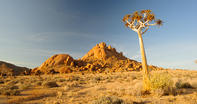Exotic People
Ages ago a number of exotic people drifted into and around Namaqualand. These included hunters, explorers, botanists, European farmers, escaped slaves and a number of so-called Basters or Bastaards (people with mixed blood).

With all these new arrivals competing for land and resources, the number of conflicts in the region escalated – especially during times of drought. There was the Bastaards. These mixed-blood ‘tribes’ were known by a number of individual names, but the colonial powers classified them as either ‘Bastaards’ (off-spring of Europeans and non-whites) or ‘Bastaard-Hottentots’ (children of slaves and Khoikhoi).
As a result of their questionable lineage, most of these people (although technically free subjects) did not qualify for citizenship within the colony. As such, they spearheaded the movement of people into the north, where they sought land for themselves.
Adam Kok
Some settlers intermingled with the indigenous Nama groups, often dominating the natives by virtue of their firearms, education or relative material wealth.
They also carried a modicum of political clout because of their Christian religion and some even managed to claim farms or grazing rights from the colonial authorities, and eventually growing quite prosperous.
The famous Adam Kok, founder of the Griqua nation, was one such individual. Kok moved from the Cape to Piketberg, where he settled on the farm Stinkfontein in 1751.
Later, he and his family moved north to the Kamiesberg where his people became active as middlemen in the trade between Europeans, the Namaqua and the southern Tswana people. Around 1780, some members of the family moved again to the Orange River, where they settled in the Kimberley area, before moving on yet again in search of a land of their own. These regular migrations were probably the result of trekboers moving in and taking over the land.
The Bosluis Basters
The Bosluis Basters get their name from their original home, the farm Bo-Sluis (above the sluice), and not from the Afrikaans word ‘bosluis’, which refers to a parasitic bush tick or louse. It’s also worth noting that the equally unfortunate term ‘baster’, which is derived from the earlier form ‘bastaard’, is maintained with some degree of pride by several baster groups (including the Rehoboth basters in Namibia).
Several commentators have written that the reason for this dates back to the 1800s, when their status as ‘half-castes’ distinguished them as being slightly better off than the inferior ‘hottentots’ and other natives. In any event, the arrival of the Bosluis Basters proved to be somewhat disconcerting to the local Khoikhoi.
I was told that, at first, the two groups were rather wary of one another and, as recently as the 1980s, a marriage between a Nama and a Baster would raise eyebrows in Eksteenfontein. Today, however, the various groups in the Richtersveld have become unified as a community and work together for the good of all.
By David Fleminger